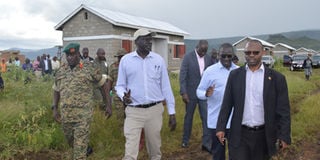Prime
Govt set to relocate more landslide victims

Monitoring. The minister for Disaster Preparedness and Refugees, Mr Hilary Onek (in cap), with other officials inspect the second phase of the resettlement project in Bunambutye, Bulambuli District, on Friday. PHOTO BY LEONARD MUKOOLI
What you need to know:
- Social services. Mr Julius Mucunguzi, the head of communication in OPM, said the construction of four primary schools, a health centre, a police station, a recreational centre, churches, mosques and commercial centres are priorities in the third phase.
The commissioner for disaster preparedness in the Office of the Prime Minister (OPM), Mr Martin Owori, has said the second phase of relocation of landslide victims in Bugisu sub-region starts in two weeks.
“All is set and most of the houses have been completed,” he said on Friday during a meeting by the inter-ministerial steering committee to review the progress on the resettlement project at Bunambutye resettlement site.
Mr Owori said the government has also strengthened its capacity to detect landslides and other disasters to avert more deaths.
“Our capacity to detect disasters is now at 99 per cent. That why this time, nobody died because of landslides,” he said.
More than 900 houses to resettle about 7,200 out of the 100,000 landslide victims will be constructed on 2,800 acres. In the first phase, 101 houses were constructed and about 720 people were relocated from the landslide affected districts.
The beneficiary districts, all found in Bugisu sub-region, are Bududa, Namisindwa, Manafwa, Sironko, and Bulambuli.
The minister of Relief, Disaster Preparedness and Refugees, Mr Hilary Onek, asked the Lands ministry to come up with a proposal for the construction of low-cost houses for landslide victims in Bunambutye Sub-county, Bulambuli District, as a way of addressing land challenges.
Mr Onek said there is a need to adopt high rise structures for the victims to create additional land for agriculture. He explained that storeyed structures can accommodate more families on an acre, which is currently being occupied by one family.
Ms Oliver Nalugo, the structural engineer in the ministry of Lands, said the proposal for high rise building is already in place.
Mr Onek added that they started to plough about 500 acres of land where each family will be allocated two acres for farming.
The construction of storeyed houses is scheduled to kick off next month after completion of 140 houses by the end of the month.
Government acquired the land in 2013 as part of a 10 -year resettlement plan. The houses are being constructed by the UPDF Engineering Brigade, the Police Construction Unit and the Uganda Prisons. The Uganda Prisons is solely in charge of making shutters and doors.
The project engineers said about 90 per cent of the houses are complete in the second phase.
“By now, the houses in this phase would be ready for handover but we were hampered by unrelenting rains, which made the roads impassable,” Col Twaha Omar Kanyoma, the officer-in-charge of the UPDF engineering brigade, said.
The district chairperson, Mr Simon Peter Wonanzofu, said the pace of the construction is slow yet more than 500,000 households are at risk of landslides in the sub-region.
“We should stop the habit of waiting to complete all houses before relocating people. We should move people now,” Mr Wonanzofu said.



